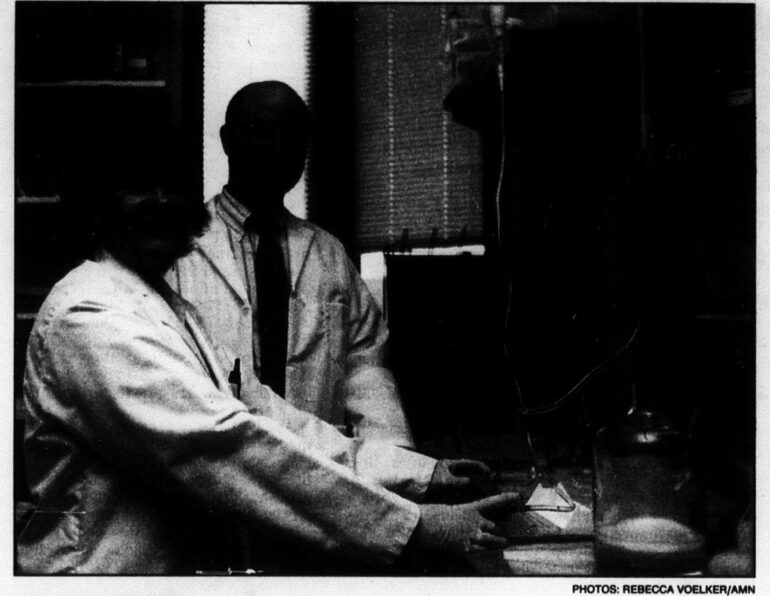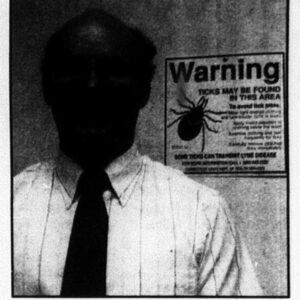Along with material from 1991, the following 1989 articles are republished with permission of the American Medical Association and included in our institutional repository.
Some notes:
- Since 1989, some information in these articles has become out-of-date. Over 30 years of science has provided answers to many questions.
- The black legged (deer) tick that causes Lyme disease in eastern North America is now known as Ixodes scapularis, not Ixodes dammini.
- Before testing criteria was standardized in the mid-1990s, it was hard to know how reliable testing was. But an epidemic of false positive diagnoses was well-documented.
- There is no link between Lyme disease and Alzheimer’s disease or Lewy Body dementia.
- In older medical literature, Lyme arthritis — both untreated and post Lyme symptoms — were often called chronic Lyme arthritis. Because of confusion, the imprecise phrase “chronic Lyme” stopped being used. As of 2020, the preferred terms for the two manifestations were “late Lyme arthritis” and “post-antibiotic Lyme arthritis.”
- We hope to get better image scans in the future.
LymeScience republishes:
Separating symptoms from hysteria
Lyme disease can bring vague complaints, media-inspired panic
By Rebecca Voelker
AMN STAFF

Although ELISA is used to detect antibodies to the Lyme-causing spirochete, results aren’t consistent, says Michael Gerber, MD, shown with research assistant Gillian Bell.

Lyme disease is a ‘difficult issue,’ says Steven Luger, MD (above). Patients such as Robert Bivona (right photo, with Robert Schoen, MD) often report non-specific symptoms.
NEW HAVEN, Conn. — On a sunny August morning, Robert Bivona looks to the sky and thanks an invisible benefactor for his appointment at Yale/New Haven Hospital’s Lyme disease clinic.
There are no Lyme disease specialists 40 miles away in Stamford, where the 44-year-old computer engineer lives. If the Yale facility hadn’t had a cancellation, Bivona would have been on his way to the next nearest clinic — in Westchester County, N.Y.
Even though he was determined to see a specialist, Bivona doesn’t appear overly concerned about his symptoms. “It’s nothing specific,” he says. “Just general fatigue and a rash.” In fact, he admits, he might be suffering more from media overkill about the disease, caused by the bite of Ixodes dammini — a tick no bigger than a dust speck.
Patients like Bivona — concerned about feeling not quite right, but having few specifics to pin it on — have been flooding physicians’ offices and hospital clinics suspecting or insisting they have Lyme disease for some two years now, since the perplexing disease started grabbing national headlines.
But troubled as the patients might be, physicians themselves sometimes are bewildered. Particularly in the Northeast, many MDs are struggling to bring the Lyme picture into focus: juggling a lineup of patients, who often insist on treatment regardless of the diagnosis, and feeling one step behind in the continuing education needed to keep up with new clinical findings.
“Lyme hysteria is out there,” said Steven Luger, MD, a family physician in Old Lyme, Conn., just a stone’s throw from the town for which the disease is named. “It’s a difficult issue when you have people who demand to be treated right after a tick bite.”
Even in the Midwest, where only Wisconsin and Minnesota have significant numbers of reported Lyme cases, the hysteria persists. “We see an awful lot more people who think they have Lyme disease, or want to have it,” remarked Joseph Duffy, MD, a rheumatology consultant at the Mayo Clinic.
THE PROLIFERATION of media attention nearly has created a herd mentality among patients, say some public health officials. “Watch Geraldo, and they ask how many people in the audience have Lyme disease. Ninety-nine percent will raise their hands,” said Matthew Cartter, MD, coordinator of the epidemiology program at the Connecticut Dept. of Health Services.
Perspective on the disease’s place in the spectrum of public health problems is difficult to come by, but reporting figures tell part of the story. According to the Centers for Disease Control, Lyme disease was reported in 43 states through the end of 1988. Still unaffected were Alaska, Hawaii, Nebraska, Wyoming, Montana, Arizona, and New Mexico.
The number of reported cases jumped from 2,400 in 1987 to about 5,000 the following year. But 92% of the cases in 1988 came from eight states: New York, New Jersey, Pennsylvania, Connecticut, Massachusetts, Rhode Island, Wisconsin, and Minnesota.
The largest number of cases came from New York, where the 2,553 reported accounted for 55% of the 1988 national total. The highest incidence of Lyme disease has been in Rhode Island, where nearly 10 of every 100,000 people have contracted the illness in 1987 or 1988. The national incidence rate is 1.4 cases for every 100,000 individuals.
“It’s important that [Lyme] be detected, because there is chronic manifestation of this disease. It’s not just a little quickie infection that goes away,” said Robert Craven, MD, acting director of the Bacterial and Zoonoses Diseases Division of the CDC’s Division of Vector-Borne Diseases in Fort Collins, Colo.
Symptoms at the onset of the illness can be vague — a red, non-itchy rash, flulike condition, fatigue, headaches, and pain and swelling in the joints. But if left untreated, Lyme can result in facial palsy, heart irregularities, arthritis, and dementia.
Last year, said Dr. Craven, Lyme disease was considered primarily a regional problem in the Northeast. Nationally, he noted, “There was more gonorrhea and measles. Lyme disease in that period was not that large a problem, but there has been a lot of growth, and a lot more states are reporting activity.”
IN THE NATIONAL reporting of tickborne diseases, Dr. Craven added, Rocky Mountain spotted fever still outdistances Lyme. “But things are in a big situation of flux,” he said. “It’s due partially to the publicity and the greater recognition of Lyme disease. But there is a definite geographic spread.” Because the first U.S. cases were recognized as recently as 1975, news accounts about Lyme sometimes read more like those of a young cottage industry.
“Lyme disease is like a little, new company that is growing rapidly. And at the moment, it is growing very rapidly,” said Robert Schoen, MD, assistant clinical professor of medicine at the Yale University School of Medicine and associate director of the Lyme disease clinic at Yale/New Haven Hospital.
Even though CDC figures track the geographic spread of Lyme disease, MDs and public health officials say there is another part to the story not as easily measured. They point to strained relationships with patients and a lack of knowledge on the part of many MDs. Some say the disease is underdiagnosed, others say the opposite.
“I’ve talked to hundreds of people [about Lyme disease] over the past four years, and this has created a sense of distrust between patients and physicians,” said Dr. Cartter of the Connecticut health department. “The patient says ‘I have it,’ and the physician says ‘No, you don’t.’ “
“Some patients are demanding treatment. They want antibiotics, but they have non-specific symptoms. The physician has to make a decision, but it’s a difficult diagnosis. The patient has symptoms and a negative blood test, or vice versa. There is a message coming across that the patient believes the doctor does not know enough about Lyme disease.”
To facilitate the education process for physicians, Dr. Cartter persuaded the Connecticut State Medical Society and Robert Massey, MD, the editor of its monthly journal, Connecticut Medicine, to devote an issue to Lyme. The issue was published last June, and hundreds of requests for reprints have come from across the country.
Perspective on the disease’s place in the spectrum of public health problems is difficult to come by, but reporting figures tell part of the story.
“The key to educating physicians is helping physicians educate themselves,” Dr. Cartter wrote in an introduction to the Lyme issue.
Dr. Massey, dean emeritus of the University of Connecticut School of Medicine in Farmington, said the issue, consisting of articles by the state’s leading authorities on Lyme, was patterned after an educational workshop he chaired last spring. He and Dr. Cartter say such workshops, conferences, and lectures, along with updates in the medical literature, are valuable educational tools for physicians, especially those in non-endemic areas who have yet to treat their first Lyme case.
“The conference heightened my awareness,” he said. “I faced a group bordering on anger. Sometimes the lay person knows more than the physician. Maybe with some justification, they go to the doctor with symptoms that may be Lyme. I heard anecdote after anecdote — they’re told it’s all in their head, they read too much, these are not the symptoms … That is not the right approach.”
Family physician Dr. Luger is familiar with some of the pitfalls of Lyme diagnosis and treatment. He now sees 100 to 150 Lyme cases a year, but the first was in 1980 as a resident at Middlesex Memorial Hospital in Middletown, Conn. “We didn’t know much about it, or what to do for it,” he recalled. After he joined a small group practice in Old Lyme in 1982, Dr Luger saw a few more cases, some in the more advanced, arthritic stage.
“Then I started realizing I didn’t know what I needed to know to practice medicine here,” he said.
At the time, he said, there were no conferences at area hospitals. The first paper on Lyme was published as recently as 1977, he added, so medical literature was too scarce to offer a wealth of information. But he kept reading new papers as they were published, and sought out lectures on the illness.
As Dr. Luger’s grounding in the medical facts grew, so did his experience as a patient. He contracted Lyme three years ago and said he saw the gaps in physician knowledge firsthand. At the hospital, another patient in the next examining room described symptoms like his own — fever, chills, and muscle aches.
“His doctor said it was the flu; my doctor said it was flu or Lyme disease. His doctor prescribed rest and aspirin; mine gave me tetracycline.”
Yale’s Dr. Schoen agrees that gaps in knowledge exist, particularly in diagnostic methods and clinical manifestations of the illness.
“It’s not so much that we need help to learn how to treat this, the biggest hurdle is getting over the obstacle of recognizing this,” he said. “If you’re in a highly endemic area, and a patient has no rash, but there are headaches, fever, and a stiff neck, in Connecticut in June that means something entirely different than it does in December.’
Diagnosis is particularly difficult, say Dr. Schoen and others, because 20% to 40% of Lyme patients never develop erythema migrans, the characteristic red, expanding rash. Without the rash, the flulike symptoms and muscle aches can easily be mistaken for a host of other ailments.
In addition, clinicians say, the enzyme-linked immunosorbent assay, or ELISA, used to test for the presence of antibodies to Borrelia burgdorferi, the spirochete that causes Lyme, is not sensitive enough to give consistent, accurate results.
“The ELISA problem is that, early on in the disease, only 10% to 40% have a positive ELISA. They get early antibiotics, and then they do not have enough antibody to have a positive test,” said Michael Gerber, MD, associate professor of pediatrics and co-director of the two-month-old Lyme disease clinic at the University of Connecticut. Even if antibody production is not masked by early doses of antibiotics, commercial laboratories have been reported to return inaccurate ELISA readings.
“The basic serologic tests are a nightmare. We can’t get the type of information we need for physicians to use as a diagnostic tool,” said Dennis White, PhD, director of the New York State Dept. of Health’s Tick-Borne Disease Institute. “Several articles lately have described situations in which physicians sent samples of the same blood to different labs and got different results. There have even been reports of intralab differences.”
Discrepancies also exist in recommended therapy with antibiotics, Dr. Schoen noted. “There has not been clear testing of some of the questions associated with duration of therapy. The earliest recommendations were 10 days of [oral] antibiotics. Later, three weeks seemed more efficacious. There has not been shown a consistency.”
Because of such discrepancies, Dr. Cartter has tried to prod the National Institutes of Health to convene a consensus development conference on Lyme disease.
“Physicians are often put in a bind … there are conflicting recommendations on how to treat this disease,” he said. “There has been a lot of research, and I believe we could develop some consensus. We’ve tried to do it on the state level — last summer we convened a small advisory group on Lyme disease and pregnancy. But we need a consensus on the national level.”
Many officials agree that a national consensus is needed, but they also say that clinical and scientific findings are still in too short a supply to standardize diagnostic and treatment recommendations.
Stephen Heyse, MD, director of the Office of Prevention, Epidemiology, and Clinical Application of the National Institute of Arthritis, Musculoskeletal, and Skin Diseases, said the NIH have three main criteria for calling a consensus conference: that the subject be a public health problem, that it pose some kind of scientific controversy, and that a base of definable scientific information exist.
Dr. Heyse said Lyme fits the first two criteria, but not the third. “There may be questions that are important — how does one diagnose, problems with false postives and false negatives in blood tests, and questions in treatment … We just think there’s a Iot that still is not known.”
But the NIH is working to shrink the gaps in scientific knowledge about Lyme disease, Dr. Heyse said. He noted that the NIH has “initiatives out there to stimulate research” and said a consensus conference on Lyme might be realistic in 1992.
IN THE MEANTIME, he said, government funding for Lyme research is increasing. NIH spending for research efforts rose from $2.2 million in 1988 to $2.4 million this year. But even though researchers and public health officials say the spending effort is encouraging, scientists who track the spread of the tiny Ixodes ticks say it isn’t enough.
“In the past [the NIH] have not favored field work on tick vectors. They seem to put most of their effort into pathogenesis, so those of us trying to control Lyme at its source, we get the short end of the stick,” said Durland Fish, PhD, director of the Medical Entomology Lab at New York Medical College in Valhalla.
Dr. Fish said tick surveillance needs to be improved in endemic areas and started in states not yet seriously affected.
The bottom line in controlling Lyme is reducing the tick population, he said, but noted that a breakthrough in eradication isn’t expected for at least another five to 10 years.
Even so, Dr. Schoen of Yale is more optimistic. “A few years ago, this was considered a localized problem. But it has changed from not being viewed as important. We’re in the game now.”

“There are conflicting recommendations on how to treat this disease.”
Problems in diagnosing, treating Lyme disease
- Symptoms — red, expanding rash, fatigue, a flulike condition, pain and swelling in joints, particularly knees — are common to a host of ailments, including arthritis.
- Some physicians and epidemiologists say the blood test to determine the presence of antibodies is not yet specific or sensitive enough to indicate an accurate response to Borrelia burgdorferi, the spirochete transmitted by Ixodes dammini ticks. Lab results vary, and physicians should be cautious of false-positive and false-negative results. False-positive results for Lyme disease can occur in patients having a variety of other illnesses, including syphilis and Rocky Mountain spotted fever.
- Because recommendations for treatment are not standardized, some physicians in high-incidence areas automatically prescribe oral antibiotics for patients with early symptoms of rash or flulike condition. Even if the patient has contracted Lyme disease, antibody tests given within the first several weeks after infection often are negative. Continued antibiotic therapy can mask the presence of antibodies, causing false-negative results in later blood tests.
For years, physicians ‘thought I was a hypochondriac,’ Lyme patient says
By Rebecca Voelker
AMN STAFF

‘Everything was getting more and more sore. My rings were squeezing my fingers.’
For more than a decade, it seemed the Murray family of Lyme, Conn., continually was racked with body aches, fevers, and rashes.
“When I look at our family history, I see that it started possibly as far back as the 1960s,” said Polly Murray, who with her husband and four children in 1975 called the medical community’s attention to a series of symptoms now called Lyme disease.
“My symptoms were bad in the ‘60s, and I was hospitalized in the ‘70s,” Murray recalled. “Most serious was the extreme joint pain, but there were the headaches, the body rashes, and I had a fever for over a year.”
For years Murray and a shopping list of physicians couldn’t find a diagnosis and treatment that meshed with her symptoms. She thought her own children and others in the neighborhood were victims of a rare outbreak of juvenile rheumatoid arthritis.
It wasn’t until Judith Mensch of nearby Old Lyme, whose daughter developed symptoms, and Murray saw Allen Steere, MD, a rheumatologist at the Yale University School of Medicine, that clues began to unfold.
By then, however, Murray had become somewhat of a medical detective herself. “I took records of all the cases” of unexplained rashes, aches, and fevers that she knew of in the area. “There were 35, in addition to the first ones — about seven or eight in Lyme or East Haddam. It was quite a few names.”
After discussing the records for an entire afternoon with Dr. Steere, now chief of rheumatology at New England Medical Center in Boston, Murray said she felt as though ‘this was the beginning of the study.”
Dr. Steere eventually described the characteristic symptoms of Lyme disease and treatment with antibiotics. But not before Polly Murray had been to “almost 30 doctors.” Even before she met Dr. Steere, Murray said she wondered about insect bites, but was told by physicians that her symptoms didn’t line up with Rocky Mountain spotted fever.
“They thought I was a hypochondriac,” she recalled. But in the search for an answer to her and her family’s baffling and painful condition, Murray said she spent considerable hours in the Yale medical library reading about a variety of illnesses, including rheumatic fever and lupus.
Since her diagnosis, Murray has been campaigning to educate physicians and the public. She has created exhibits for schools and libraries, is a member of a legislative task force trying to get more state funds for Lyme research in Connecticut, and has spoken to physicians and medical students.
Although treatment and diagnoses have vastly improved, recognizing Lyme disease is one of the toughest aspects of the illness for both physicians and patients.
“I went on a canoe trip at the end of May,” recalled Shelley Abraham, of Columbus, Ohio. “A couple of weeks later, I thought I had poison ivy. I had a rash on my right leg, but it just went away. It goes away and you don’t worry about it.”
But after the rash disappeared, Abraham developed a stiff neck and small lumps along her throat. An MD said she had the flu, but the stiffness started spreading to her hands and knees.
“Everything was getting more and more sore,” she said. “My rings were squeezing my fingers.”
Abraham sought a second opinion, and after a positive antibody test she was diagnosed with Lyme. She took oral antibiotics four times a day for six weeks, but when she stopped, the symptoms reappeared almost immediately. Now, she injects antibiotics twice a day into a chest catheter.
“They thought it could be moving into my central nervous system, and that there could be personality changes,” she said, taking the ordeal in stride.
Abraham said two of the three physicians she consulted appeared knowledgeable about Lyme disease, but could have displayed more confidence. “They should get together,” she said. “They seem so unsure — ‘This is what most doctors seem to be using on their patients’ — it’s not very reassuring when a doctor says that.”
It’s been a year since Margie Wojdyla of Palatine, Ill., contracted Lyme disease after she was bitten by a tick during a camping trip. Even though she has completed oral antibiotic therapy and had a recent negative blood test, she fears that symptoms could return.
“The second test was negative, so that has soothed me for a while,” she said. “But I still might get headaches, so I’ll probably wonder whether it’s (Lyme) again, or just caffeine or stress.”
Used with permission of the American Medical Association. AMA, American Medical News, Separating symptoms from hysteria, 1989, September 22/29, pp. 9-11. © Copyright American Medical Association 1989. All rights reserved. Courtesy of AMA Archives.